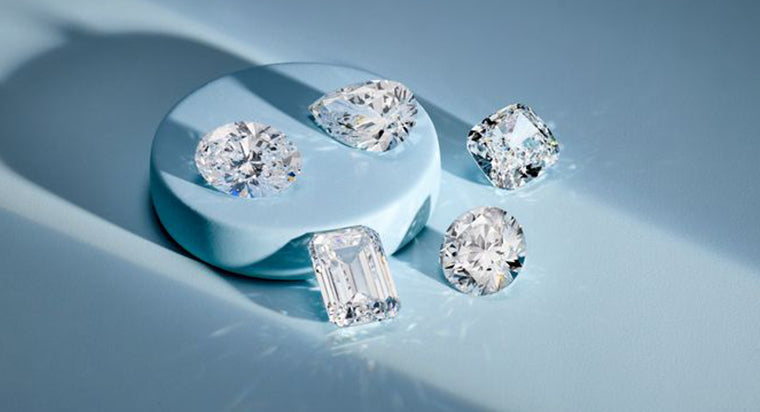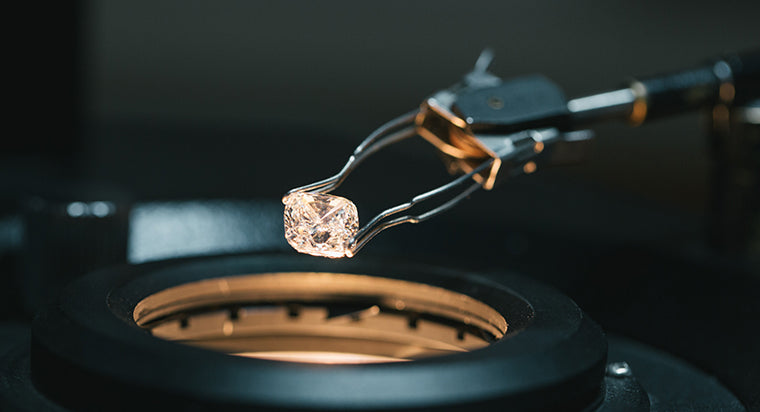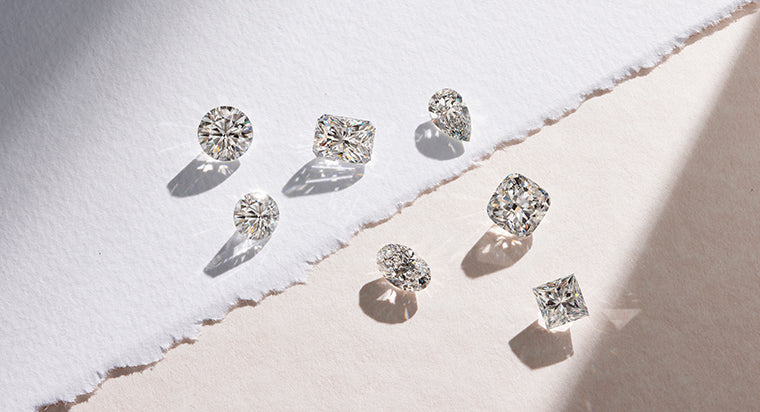Lab Grown Diamonds in 2025: Pros, Cons, Value & Buying Guide

If you're shopping for diamond jewelry in 2025, then you've probably come across lab-grown diamonds. They've become the hottest topic in the jewelry world. Everyone from Meghan Markle to Emma Watson has been spotted wearing lab-grown jewelry both casually and on red carpets. What's more? Even Millennials and Gen Z are embracing lab-grown diamonds, owing to their modern appeal, sustainability factor, and often friendlier price tags.
With so much buzz surrounding them, it's natural to wonder if they are worth it. Today, we'll dive into the benefits and drawbacks of lab-grown diamonds so you can decide for yourself and see what the buzz is all about!
TABLE OF CONTENTS
Are Lab-Grown Diamonds Real Diamonds?
Yes. Lab-grown diamonds are real; they have the same chemical, physical, and optical properties as natural diamonds, which means they offer the same sparkle and hardness (yes, they score 10/10 on the Mohs scale). So, what's the difference? The only difference is that they're created using cutting-edge technology in a controlled laboratory setting that replicates the conditions used to create a natural diamond. Through extreme temperatures and pressure, carbon is transformed into a diamond, just like it does below the Earth's crust.
So, How are Lab-Grown Diamonds Made?
In the lab, you can create diamonds using two methods: High Pressure High Temperature (HPHT) or Chemical Deposition (CVD).
- HPHT (High Pressure High Temperature): A diamond seed (a small, natural diamond fragment) is added to carbon. This seed is then placed under extreme heat (over 1500 °C) and pressure (~1.5 million pounds per square inch), causing carbon to crystallize and form a lab diamond.
- CVD (Chemical Vapor Deposition): In this method, a diamond seed is placed in a vacuum chamber containing carbon-rich gas and plasma. It's then exposed to high temperatures (over 1000 °C), causing layers of lab diamonds to build atom by atom.
Also Worth Knowing
Newer CVD techniques now produce Type IIa gems, which are among the purest and most valuable lab diamonds available. Many lab-grown diamonds even undergo high-pressure annealing to enhance their clarity and color.
Lab-Grown Diamond: The Pros
In addition to the unique processes that create ultra-pure lab diamonds, these stones also have some other interesting benefits:
- Sparkle, shine, and durability: Lab-grown diamonds match natural diamonds in terms of brilliance and wearability. Their optical structure gives them sparkle and fire that imitation stones, such as Moissanite or cubic zirconia, simply can't replicate. They're also just as durable as mined diamonds, ranking a perfect 10 on the Mohs scale, making them excellent for everyday wear.
- Cost savings: Lab diamonds are typically 30–50% less expensive. For instance, a 1-carat natural round diamond of G color, VS2 clarity, and very good cut can cost anywhere between $6,000 and $8,000. On the contrary, a lab-grown diamond with the exact specifications can range from $ 1,000 to $ 2,000. This significant price difference allows buyers to choose larger carat weights or opt for higher color and clarity grades while staying within their budget!
- Conflict-free and eco-friendly: Due to shorter supply chains and smaller carbon footprints—especially when labs use renewable energy —lab diamonds are quickly emerging as a sustainable and eco-friendly option. Recent studies from 2024 and 2025 suggest that lab-grown diamonds generally have a significantly smaller carbon footprint than mined diamonds. It's no surprise, then, that they've become a top pick for couples seeking eco-friendly engagement rings.
- Variety and availability: Whether you're shopping for engagement rings, bracelets, necklaces, or earrings, you can easily find lab-grown diamonds in every jewelry style imaginable. Lab diamonds are widely available in a variety of popular shapes, ranging from oval, emerald, pear, and cushion in both classic and trendy settings such as bezel, hidden halo, and east-west settings. This gives the buyer endless options to match their personal style.
Lab-Grown Diamonds: The Cons
Of course, we can't mention all the benefits of lab-created diamonds without also mentioning their drawbacks.
- Value retention: Lab-grown diamonds tend to have lower long-term value retention compared to natural diamonds because of their abundant supply and increasingly efficient production. As technology advances, prices may drop. However, since lab-grown diamonds generally cost less upfront, their depreciation value also tends to be smaller in terms of dollars. In contrast, while natural diamonds may hold their value slightly better percentage-wise, they often see a higher dollar depreciation because of their significantly higher initial cost.
- Resale options: When it comes to resale, the overall value of a piece of jewelry—design, brand, craftsmanship, and condition—often matters more than whether the diamond is lab-grown or natural. For lab-grown diamonds specifically, resale value tends to be lower due to their widespread availability and declining production costs. But if your piece is well-crafted, especially from a reputable jeweler and in an excellent condition, it can still hold meaningful value.
- Energy use: The environmental impact of creating lab diamonds varies. Some producers use 100% renewable energy to generate intense pressure and heat, while others rely on non-renewable sources. Still, lab-grown diamonds are more environmentally efficient compared to mined diamonds which require unearthing 100 tons of ore per every 1 carat of natural diamond.
Lab vs. Natural Diamond Comparison 2025
As discussed earlier, the only difference between lab and mined diamonds lies in their origin, cost, and resale potential. Natural diamonds tend to retain their value over the long term. Still, lab-grown diamonds offer ethical sourcing, transparency, and price flexibility. For modern shoppers, choosing between the two often comes down to aligning personal values with budget and style preferences.
Engagement Ring Buying Behavior in 2025
Given that they're beautiful, affordable, and offer sustainability benefits, lab-grown diamonds have become a highly sought-after choice for engagement rings. A recent survey found that 62% of buyers now prefer lab-grown diamonds over natural ones, and this trend is expected to continue growing.
Contrary to what one may think, it's not just the reduced prices that influence their purchasing decisions – it's driven by sustainability and ethical sourcing practices.
The fact that lab-grown diamonds are available in a wide range of trendy diamond cuts, such as oval, pear, emerald, and cushion, also helps further their popularity. Today, you can easily find a high-quality lab-grown diamond engagement ring online at With Clarity with a hidden halo, a sleek bezel, or even a classic solitaire setting. What's more? You can easily customize these rings as per your style and preferences.
A Few Lab-Grown Diamond Buying Tips
- Certification Matters: A diamond certificate or grading report is issued by an independent gemological laboratory. Therefore, it's unbiased and provides details about your diamond, such as quality, carat, and cut. When purchasing lab-grown jewelry, always insist on a diamond certificate (from reputable labs such as GIA or IGI) to verify the quality and authenticity of your gem. At With Clarity, we provide an IGI certificate with all our lab-grown diamond jewelry so you can shop with confidence.
- Shape & Setting Choices: While round-cut is a timeless choice, popular cuts, such as oval or pear, offer more face-up size per carat. In terms of settings, you can always opt for a classic solitaire style if you're looking for a minimalist look for your engagement ring. But halo, three-stone, and vintage rings are more opulent. Even east-west styles and bezel settings can be considered by those who want unconventional engagement rings.
- Review retailer policies: Check the return and resizing policies, financing options, and customer reviews before making a purchase. It's worth researching the best place to buy lab diamonds online and prioritizing those that offer warranties and have a strong reputation for customer service.
Is a Lab Diamond Right for You?
While lab-grown diamonds have a lot to offer, you may be wondering if they're worth it. And the answer is: it depends on you!
Lab-grown diamonds offer the same beauty, sparkle, and durability as mined diamonds without impacting the environment, making them a brilliant and ethical alternative. Still, it boils down to personal values and priorities. Think about your budget, how you feel about diamond sourcing, and the environmental impacts of diamond mining. Weighing all these factors should help you decide which diamond works best for you.
Aside from selecting a stone, be sure to research the best place to buy lab-grown diamonds online and examine the brand's reputation, warranty, and other relevant factors to make a confident purchase. At With Clarity, we offer a curated selection of diamonds and have a team to guide you through the buying process so you can truly find a piece you love.
FAQs
Are lab-grown diamonds real?
Can lab-grown diamonds be tested as real?
Will lab-grown diamonds lose value?
How long do lab diamonds last?
What is the best place to buy lab diamonds online?









